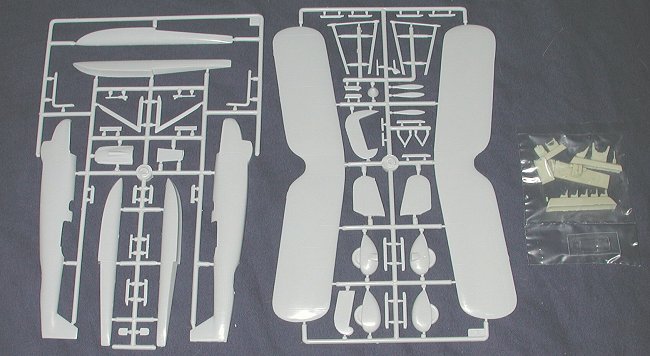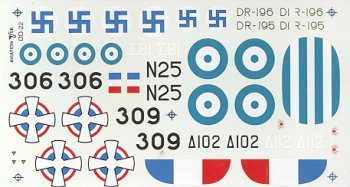
|
KIT: |
Xotic-72 1/72 Dornier Do-22 |
|
KIT # |
AU2026 |
|
PRICE: |
$24.95 |
|
DECALS: |
Three aircraft |
|
REVIEWER: |
|
|
NOTES: |
Short run with vac canopy and resin bits |

|
HISTORY |
In the years between WWI and WWII Dornier made a name for itself in the design of water borne aircraft. Though initially doing flying boats, and doing them quite well, it eventually decided it had to expand its abilities into doing land planes. Two reasons; one is that the market for flying boats is limited; the second is that they was a growing need for these types in the upcoming new Germany after 1933. However, Dornier still had to 'get out of the water' so to speak and the Do-22 was probably one of the designs that helped that along.
The Do-22 was developed in 1934, being initially designed in Switzerland and then moving to the Friedrichshafen factory. It was a three seat reconnaissance and light bomber float plane. In addition to operating on floats, this high winged monoplane was also able to operate on land when the floats were replaced by wheels. Though the two prototypes were wrung out by the German military, they decided not to pursue it and provided Dornier with permission to export the aircraft. Buyers were found for the plane in Greece, Latvia and Jugoslavia.
First production aircraft flew in July of 1938. It was powered by a Hispano-Suiza 12-cylinder liquid cooled engine producing 860hp and driving a three bladed prop. It was basically metal construction with fabric covering except those areas around the engine and the float, which were metal. Armament was a twin mount for the rear gunner, one above the engine and one aiming down in the aft fuselage. Of the thirty produced, some were captured by the Germans, who later handed them over to the Finns who operated them on floats and skis. Some Jugoslav aircraft were used by the British after they were flown to Egypt when their country fell to the Germans, but that usage was short-lived due to lack of spares.
|
THE KIT |

What you have here is your standard Czech short run kit. There are two sprues of light grey plastic with very nicely detailed engraved panel lines where needed. The fabric covering is quite subdued as it should be. There is very little flash, no sink marks that I could find and the ejector pin stubs are on the inside of parts. They will have to be removed from the wings. There is a small vac windscreen. Most of the interior and finer bits are in resin, though thankfully there are not a lot of them.
The kit does have the cursed separate prop blades (which I personally don't like), but the rest of the kit is pretty normal for the genre. What is very nice is that there are detailed construction notes on the instruction sheet. Xotic 72 doesn't leave you in the lurch on this one. There are several pitfalls that they help you through, including the fact that the strut placement dimples on the wings are in the wrong place and that the resin interior is too narrow. If you recall, I have mentioned that on these kits, the people who do the plastic and those who do the resin don't talk to each other so fit problems can be expected when using these parts.
 According to the box top, there
are markings for six aircraft. OK, let's find them. First is a Finnish version
as shown on the box art. On the back is a second Finnish profile, this one on
wheels. Also there are profiles for a Greek aircraft in overall aluminum and a
Jugoslav version in camouflage. That makes four. On the box ends are the other
two; a second Jugoslav plane in overall aluminum with a dark green mottling on
the upper surfaces; and a Greek plane in camouflage and on wheels. The decal
sheet is superbly done and is probably done by Propagteam. Looking at the sheet,
it seems as if we have to amend the list. Basically I only see a serial for a
single Finnish aircraft, so make that markings for five: one Finnish, two Greeks
and two Jugoslavs. It would have been nice to have a Latvian plane added, but
pictures of that seem to be rather scarce. One other little thing is that
the two wheeled versions are shown without the spats, yet you can only do a
wheeled version WITH spats. Methinks some additional research will have to be
done concerning the wheeled variants.
According to the box top, there
are markings for six aircraft. OK, let's find them. First is a Finnish version
as shown on the box art. On the back is a second Finnish profile, this one on
wheels. Also there are profiles for a Greek aircraft in overall aluminum and a
Jugoslav version in camouflage. That makes four. On the box ends are the other
two; a second Jugoslav plane in overall aluminum with a dark green mottling on
the upper surfaces; and a Greek plane in camouflage and on wheels. The decal
sheet is superbly done and is probably done by Propagteam. Looking at the sheet,
it seems as if we have to amend the list. Basically I only see a serial for a
single Finnish aircraft, so make that markings for five: one Finnish, two Greeks
and two Jugoslavs. It would have been nice to have a Latvian plane added, but
pictures of that seem to be rather scarce. One other little thing is that
the two wheeled versions are shown without the spats, yet you can only do a
wheeled version WITH spats. Methinks some additional research will have to be
done concerning the wheeled variants.
|
CONCLUSIONS |
If you are used to doing short run kits, then this one will hold no surprises. The superb instructions will only enhance the building experience and will help over the problem areas you will encounter. This is a great subject for a kit and one that should do well. I have seen it built and it really is an eye-catcher. You can get it direct from the link below.
Review kit courtesy of the fine folks at Aviation USK Nebraska. Thank you for your support.
If you would like your product reviewed fairly and quickly by a site that has well over 150,000 visitors a month, please contact me or see other details in the Note to Contributors.